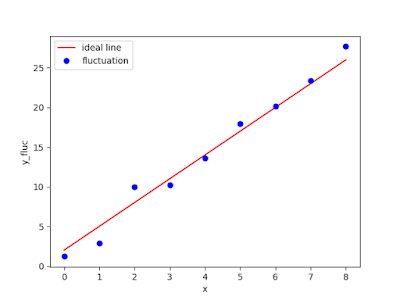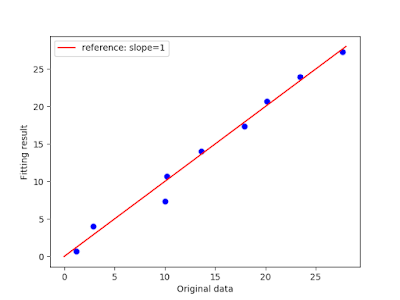PyTorch (3) Linear regression
This is an example about Linear Regression with PyTorch.
We add the fluctuation to the linear data and fit it with a linear model. Finally, we plot a 2-D figure to show the training result. If the training result perfectly fit the original data, the slope should be 1.
1. Prepare the data to be fitted:
Add the fluctuation to the linear data:
import numpy as np x = np.array([[xi for xi in range(10)]]) y = 3*x+10 fluctuation = np.random.randn(y.shape[0], y.shape[1]) y_fluc = y+fluctuation
from matplotlib import pyplot as plt plt.plot(x[0,:], y_fluc[0,:], "o") plt.show()

2. Construct the model:
We create a class which inherits torch.nn.Module.
A linear layer (torch.nn.Linear) is add to the init process.
class LinearRegression(nn.Module):
def __init__(self):
super(LinearRegression, self).__init__()
# create a linear layer
self.fc1 = nn.Linear(1, 1)
def forward(self, x):
"""compute and return the result.
"""
out = self.fc1(x)
return out
LinearRegression.forward is used to compute the predictive result.
3. Complete program:
This example use CUDA tensor. Modifing xxx.cuda() to xxx to use CPU tensor.
import torch
from torch import nn, optim
import numpy as np
import matplotlib.pyplot as plt
class Net(nn.Module):
def __init__(self):
super(Net, self).__init__()
self.fc1 = nn.Linear(1, 1)
def forward(self, x):
out = self.fc1(x)
return out
if __name__ == "__main__":
x = np.array([[i for i in range(9)]], dtype=np.float) # shape (1,9)
x = x.T # reshape to (9, 1) to fit torch
y = 3 * x + 2 # shape (9, 1)
plt.figure("Before fitting")
plt.plot(x[:, 0], y[:, 0], "r-", label="ideal line") # plot the ideal line
fluctuation = np.random.randn(y.shape[0], y.shape[1])
y_fluc = y + fluctuation
plt.plot(x[:, 0], y_fluc[:, 0], "bo", label="fluctuation") # plot training data
plt.xlabel("x")
plt.ylabel("y_fluc")
plt.legend()
x_train = torch.FloatTensor(x).cuda()
y_train = torch.FloatTensor(y_fluc).cuda()
mse = nn.MSELoss()
net = Net().cuda()
optimizer = optim.SGD(net.parameters(), lr=1e-3)
steps = 100
error = []
for step in range(steps):
y = net(x_train)
loss = mse(y, y_train)
error.append(loss.cpu().detach().numpy())
optimizer.zero_grad()
loss.backward()
optimizer.step()
plt.figure("Train result")
plt.plot(y_fluc[:, 0], y.cpu().detach().numpy()[:, 0], "bo")
plt.xlabel("Original data")
plt.ylabel("Fitting result")
plt.plot([0, 28], [0, 28], "r-", label="reference: slope=1")
plt.legend()
plt.figure("MSE")
plt.plot(error)
plt.show()
We tried to minimize Mean squared error which measures the average of the squares of the errors of the data with SGD optimizer.


留言
張貼留言